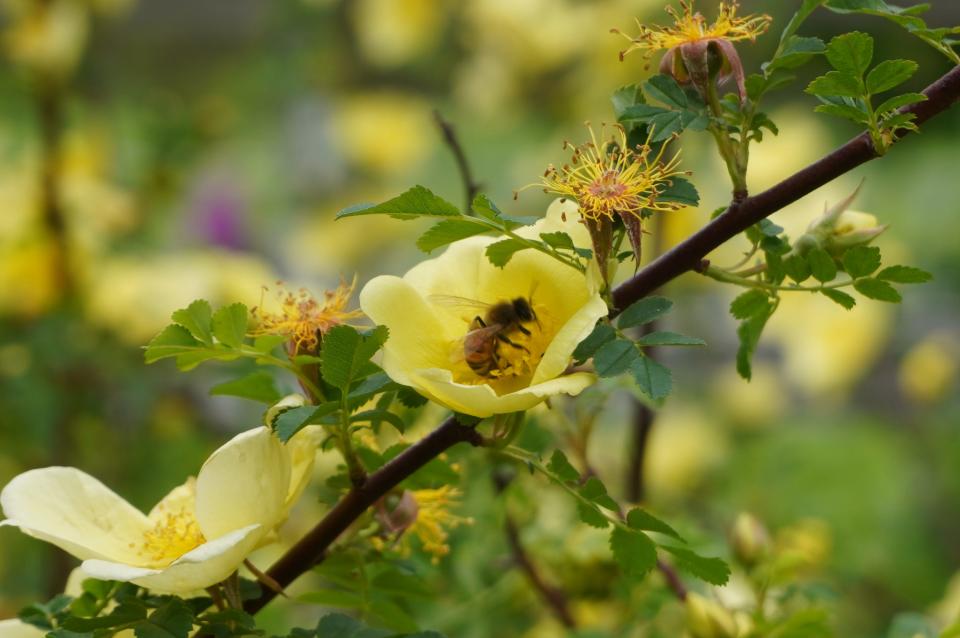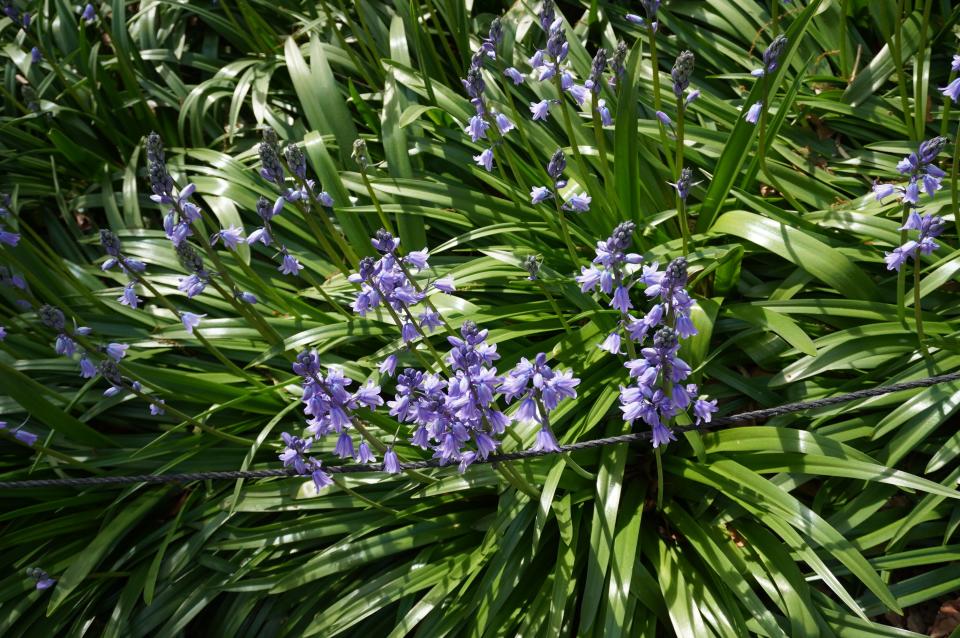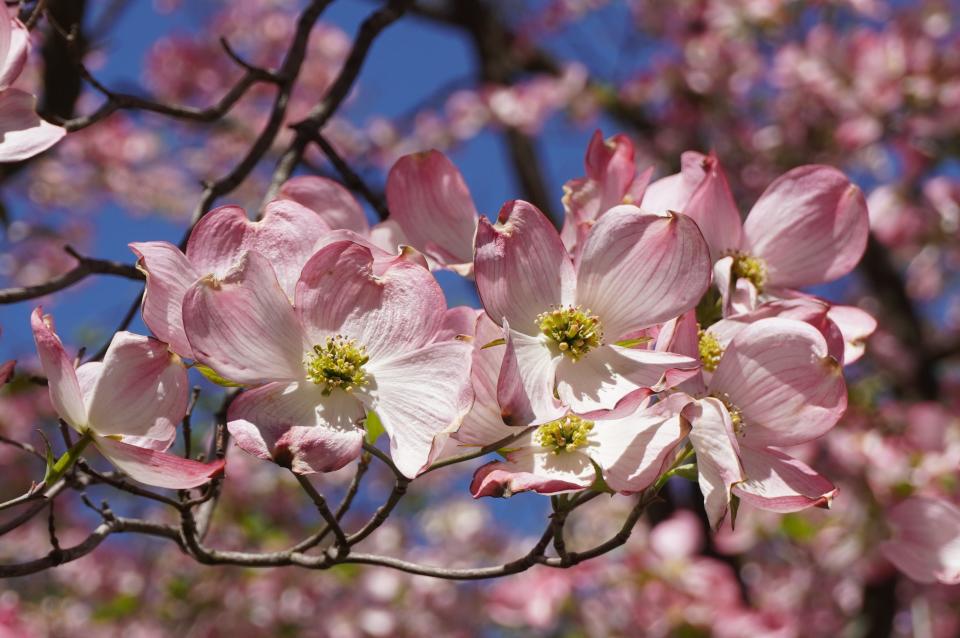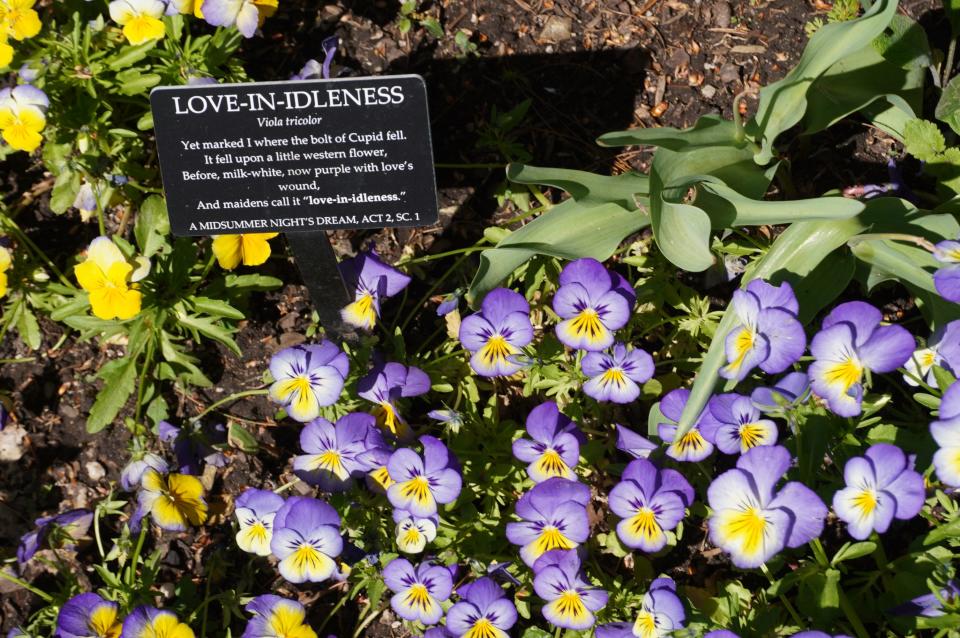Plant Lovers' Almanac: Plants' debut in NYC sets the stage for Ohio
Last week was a split plant-loving experience for me, first in New York City, then back to Northeast Ohio. Flowering dogwoods were in full flourish in Brooklyn, and upon return we noticed our old dogwood near the front of our house just coming into its show. Early roses, such as “Canary Bird” were out in their soft yellows at the Cranford Rose Garden at the Brooklyn Botanic Garden (BBG). Tree peonies were starting their star turn at BBG. Azaleas, here and there, were stunning.

The Cherry Walk at the BBG, planted in 1921, was just at its end for this year; tulips were still infinitely charming; elm trees were en masse fruiting, sometimes making it look as if the trees were in trouble and not leafing out; and the spectacular golden-chaintree (Laburnum) was in bloom, as were double-file viburnums.
At rest areas along Interstate 80 in Pennsylvania, there was a lovely patch of wood sorrel (Oxalis) in soft pink bloom.

Back in Ohio, the mayapple patch in our yard, transplanted 35 years ago from central Ohio, was in full umbrella-mode, and the waxy white flowers showed their faces beneath the canopy. White violets (Viola) carpeted a repurposed old vegetable garden in our backyard. Dual-colored bleeding-heart blossoms lined up along the flower stems. Yellow magnolias are blooming at the Ohio State University’s Secrest Arboretum in Wooster. Tiny emerging leaves on many species of oak trees are the type of sight unique to spring. Do not miss it!

Spanish bluebells
(Hyacinthoides hispanica) “Excelsior.” One of the many features at the Brooklyn Botanic Garden is the Bluebell Woods, featuring this native of the Iberian Peninsula. It is in the asparagus family with lance-like leaves typical of its relatives such as yucca, hosta, Solomon’s seal, asparagus and close but reclassified members of the lily family. A fellow wanderer of the BBG, who said he had not missed a week visiting in the past 13 years except for four months of COVID, said the bluebells were only a week early from their peak.
Something that I did not notice, but which I will check out on my next May-time visit, is that in addition to the purple-blue petals, references indicate that it has purple-blue stamens, the pollen-bearing male part of the flowers. This distinguishes it from other related bluebell species. Spanish bluebell is a bulbous perennial that can tolerate shade. It is not related to our native Virginia bluebell (Mertensia virginica), a lovely delicate pink-turning-to-blue native wildflower.
Spanish bluebells do cross with a species of related bluebells in the United Kingdom and are considered invasive in some areas, though, to my knowledge, not seen spreading to native areas in Ohio.

Dogwoods
Flowering dogwoods (Cornus florida), both white and pink versions, and hybrids of flowering dogwoods with Cornus kousa were glorious in New York City and now here. And some of the less spectacular but lovely dogwoods are now ready to bloom, such as the alternate-leaf dogwood in my backyard.

Monsters in our midst
As a plant pathologist and plant health specialist, ever fascinated by plant disease and other problems, such as insect attacks on plants, I can be irritating to be around, noticing problems in your garden and houseplants.
Travel is no different, so on my recent trip I noticed the serious problems of hemlock woolly adelgids in Brooklyn and gypsy moth egg masses on oaks at Pennsylvania rest areas (these stopovers are a gold mine for those such as me!). Also some Taphrina fungus causing galled areas on a cherry street tree and the first I had seen of tent caterpillars on wild cherries, again at those fascinating Pennsylvania rest areas.
Emerald ash borer, a particularly devastating example of a non-native insect causing damage as worlds collide with its arrival in North America several decades ago, is a problem both in New York and Ohio. Billions of trees have perished, but literally along the Q line subway as we left Ditmas Park in Brooklyn one morning, there was one tough, but almost certainly doomed ash seedling, still trying to eke out a living for now.
Rose family revisited
I wrote last week about the many flowering trees in the rose family along roads: invasive Callery pears, native serviceberries and hawthorns, and — crab apples. Though a lifelong crab apple lover and researcher for 40 years, I still have to ask: What makes crab apples OK and Callery pears not so?
It is not clear-cut. First, the term “native” often turns in the minds of most naturalists upon the idea of whether a plant was in an area prior to European colonization. By that metric, the Asian-origin Callery pears were not; some crab apples were because of migration from their native central Asian origins via land-bridges and early continental connections.
Second, I could play the pleasantness card: Callery pears might be beautiful in flower, but they do not smell as good as crab apples. These pears have ugly, dull brown fruits; crab apples have purples, reds and yellows. Callery pear flowers come only in white and not the corals, pinks and whites of crab apples. Crab apples have weepers, spreaders, upright forms, while these pears are pretty much just upright forms.
Yet the key in my opinion is that we are used to crab apples, and Callery pears are more recent additions. Both are spread by Angry Birds and end up in areas where they were not planted and sometimes not wanted. In the final analysis, though, I suspect that the big difference is their publicist: in the case of crab apples (and their larger versions in the genus Malus) – Johnny Appleseed!

Viola
Speaking of the genus Viola above, including wild violets, as well as many wild and horticultural types such as Johnny-jump-ups and pansies, there was a lovely version in the Shakespeare Garden at Brooklyn Botanic Garden, of Viola tricolor (love-in-idleness). From “A Midsummer Night’s Dream”:
“Yet marked I where the bolt of Cupid fell.
It fell upon a little western flower,
Before, milk-white, now purple with love’s wound,
And maidens call it “love-in-idleness.”
Jim Chatfield is a horticulture educator and professor emeritus at Ohio State University Extension. If you have questions about caring for your garden and other topics, write to chatfield.1@osu.edu or call 330-466-0270. Please include your phone number if you write.
This article originally appeared on Akron Beacon Journal: Plant Lovers' Almanac: Plants' debut in NYC sets the stage for Ohio

